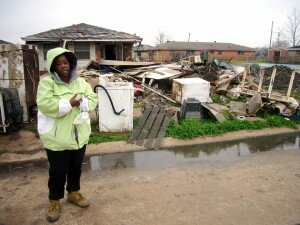Author Archive
Like sustainability, branding needs image change
A new study indicating the recession has crowded out concern for the environment prompted the New York Times to ask: “Is ‘thinking green’ an economic luxury?”
Uh, yeah. Not that it should be. If ever there was an economic necessity it would be to think green and adopt sustainable practices. But that’s just me speaking. My professional niche is sustainable branding, so I see business through the lens of sustainability. Plenty of recent studies show the continued gap between intention and action on sustainability among individuals and businesses.  Neither thinking nor acting green is considered essential.
Neither thinking nor acting green is considered essential.
Like sustainability, branding is viewed as a luxury by most in business. Ironically, that’s farthest from the truth in lean times like these. When acquiring and keeping customers is hardest, a business can least afford to ignore what creates competitive distinction and customer relevance — namely, its brand.
Branding’s image problem
Branding suffers from an enduring image problem. Mention branding, and dollar signs come to the minds of most executives. In a recession, that’s a show-stopper. The problem is branding is equated with design, advertising, marketing communications — all of which cost money. But brand promotion is only part of the branding equation — the most expensive part.
Yes, at some point, you have to build brand awareness, preference and loyalty. And that requires a financial investment in marketing. But the most essential components of building your brand — defining what it is and baking it into your culture, operations and products — are really just best management practices.
Branding is little different from other standard best practices, such as developing financial budgets, employment policies or product development plans. Sure they take some time and money to produce, but that’s simply the requirement of being in business, no matter the economic climate. So it is with branding.
When businesses declare branding a luxury they can’t afford, they are unwittingly saying, “We aren’t going to take the time to decide who we are as a business, what we stand for, what makes us distinct and why we matter as a company. And we’re not going to worry about whether we as managers and employees are keeping our promise as a business to customers and all our other stakeholders.”
Consequences of brand neglect
I used the word “unwittingly” because I don’t believe most business executives understand the consequences of neglecting their corporate brand until more prosperous times return.
 It’s one thing to slash advertising budgets or postpone the redesign of the firm’s visual identity. It’s quite another to lose sight of what makes your business distinct and relevant now, today, in an economy fundamentally different from just two years ago. Or to postpone accountability for whether your business is consistently delivering the customer experience you promise.
It’s one thing to slash advertising budgets or postpone the redesign of the firm’s visual identity. It’s quite another to lose sight of what makes your business distinct and relevant now, today, in an economy fundamentally different from just two years ago. Or to postpone accountability for whether your business is consistently delivering the customer experience you promise.
From the inside looking out, your brand is your over-arching promise to stakeholders. From the outside looking in, your brand is the image stakeholders have of your business, based on direct experience or word-of-mouth. Any business with customers or employees has a brand image. The question is whether the business understands and cultivates that image or leaves the task to others, such as competitors who are only too willing to tell your story for you.
At its most basic, branding means ensuring the experience aligns with the promise. That’s not accomplished by simply spending more money on clever advertising or glitzy marketing events. Much more important is being clear about what your promise is as a company and how your employees, products and practices deliver on it day after day, regardless of the economy.
Branding as necessity
Seen from this perspective, branding is no luxury. And it doesn’t have to be about spending big bucks. What it does require is time and commitment from senior leadership to ensure the brand:
- firmly establishes competitive distinction and customer relevance
- is understood and fulfilled across the company
- is positively perceived by customers, employees and other key stakeholders
Branding is an all-company, everyday exercise in earning and keeping customers and creating competitive advantage. When times are toughest, attention to your brand becomes more crucial than ever.
Does branding need to be on your list of business necessities? If so, I invite you to get in touch and explore how to make that happen.
Does happiness have anything to do with business?
Described elsewhere as the “happiest man in the world,” Tibetan Buddhist master Yongey Mingyur Rinpoche reminds his audience what we inherently know and usually forget: Happiness lies within.
I heard Yongey Mingyur speak at a recent Portland State University event on “sustainable happiness.” As a sustainability advocate and a sometimes meditator, I couldn’t resist attending.
We in the US might want to listen to what Yongey Mingyur has to say. Despite being a country that enshrined the pursuit of happiness in its Declaration of Independence, the US ranks down most lists of the happiest countries. Probably not surprising given how we’ve managed to conflate happiness with having or buying more things.
A 2,500-year-old practice mastered by the likes of Yongey Mingyur suggests the cultivation of mindfulness as an alternative path to happiness. And what happens to be on my mind as I blog today is this: Does happiness have anything to do with business?
Fair question, it seems, given the ongoing economic upheaval. These are hard times in many workplaces. Employees who withstood layoffs now asked to do more. Wage rollbacks or miniscule raises. Desperate competitors slashing prices and everyone’s profit margins. And now, worry about a double-dip recession. What’s there to be happy about — other than still being in business or having a job?
In my experience as a business owner, consultant and employee, happiness eludes most businesses even in the best of times. Best, in this case, means periods of rapid revenue and profit growth. It’s the rare company in the midst of a boom cycle that declares, “Enough. We’re happy with what have.” Most cling to the notion that if your business isn’t growing, it’s dying.
Survival of the paranoid
In good times and bad, business is a practice in survival. And as Andy Grove, founder of one of the world’s most successful companies, Intel, famously asserts, “Only the paranoid survive.” He may have a point. Intel CEO Paul Otellini last month declared Q2 2010 “the best quarter in the company’s 42-year history.” And that’s in the midst of the Great Recession!
So should we be nurturing “Intel Inside” all of our businesses, rather than happiness? If we did, we might find the company voice within sounding something like Andy Grove when he writes:
Business success contains the seeds of its own destruction. The more successful you are, the more people want a chunk of your business and then another chunk and then another until there is nothing left. I believe that the prime responsibility of a manager is to guard constantly against other people’s attacks and to inculcate this guardian attitude in the people under his or her management.
Not exactly a happy-sounding voice. But maybe happiness is something we pursue only in our off hours. And maybe Nirvana’s Kurt Cobain was speaking for business when he sang: “Just because you’re paranoid don’t mean they’re not after you.”
FUD instead of happiness?
Or maybe we should be listening to Yongey Mingyur whose tradition maintains: “The basic concern shared by all beings—humans, animals, and insects alike—is the desire to be happy and to avoid suffering.”
We don’t avoid suffering by inviting fear and paranoia to rule our lives. Why would it be any different in business?
Truth is, we’re not very practiced at cultivating happiness, at work or outside of work. In fact, we’re much more skilled at sowing fear, uncertainty and doubt. In business parlance, it’s simply called FUD. Surround your competitors with FUD so your customers are more apt to choose you. Contrary to human nature, business doesn’t avoid FUD; it rewards it!
So back to my question: Does happiness have anything to do with business? Sure. We all want delighted customers. Even Andy Grove. And yet how many of us believe the purpose of business is to help others—customers, employees, partners, neighbors—be happy? I’m guessing, not many. In other words, happiness doesn’t have that much to do with business.
What if…
What if business was all about happiness? What if we were to follow the lead of the happy country of Bhutan, as hotelier and author Chip Conley recommended in his recent TED talk, and create “a habitat for happiness” in our businesses?
For starters, we might catch up with our customers, more of whom are realizing the futile chase for happiness through more stuff. As the New York Times reported this month, more Americans are responding to today’s economic realities by simplifying their lives, spending more on experiences than possessions and generally getting in touch with what really matters, like relationships with family and friends.
So what do you think? Does business have any business cultivating happiness? Or is it true, only the paranoid survive?
10 steps to employee engagement in sustainability
Today’s guest post is by Eric Brody, a member of the R.Bruer Sustainable Branding Collaborative. Eric is founder and principal of Shift Advantage, a sustainability consultancy in Portland, Ore. He was previously the sustainability business integration manager for Nike and sustainability manager for Nau, a technical outdoor and urban clothing company recognized for its innovative sustainability practices.

Much has been written about how to involve employees in more environmentally friendly office practices, such as reducing paper consumption, carpooling, turning off computers at night, recycling, and composting food scraps. As important as these and many other behaviors are to greening an office, they only take a business so far down the sustainability path.
If your vision is to build a sustainable business operating from a triple-bottom-line (people, planet, profit) philosophy, then sustainability is core to your business strategy. Your challenge involves more than green office practices. It means creating a business whose success is measured by its social, environmental and financial contributions.
Executives can only achieve their vision of a sustainable business by engaging and involving their work force. They need everyone in their companies on board. The question is how to engage all employees in the practice of strategic sustainability.
Fully engaging employees in strategic sustainability
At the risk of over-simplifying what can be a complex undertaking, I’ll offer a 10-step approach to employee engagement:
- Develop a strategic business plan that clearly articulates your social, environmental and financial objectives and strategies over a period of up to five years. I’ve worked with companies that set very aggressive stretch goals such as zero waste or zero carbon footprint by a certain date to ones that set more pragmatic goals such as reducing waste or the carbon footprint by a certain percentage.
-
Share your business plan with each group or department. Ask each group to review their individual plan and goals with the intention of incorporating or expanding the practice of sustainability into their metrics of success. Each unit may be different: Purchasing may adopt social and environmental performance requirements in their procurement contracts with suppliers. Product development and design may adopt design for environment (DfE) techniques into their processes.
 This type of thinking leads to innovations such as creating products that are lighter, repairable, utilize rechargeable energy sources, use energy more efficiently, or require low impact cleaning by the user. Accounting may investigate new models for measuring and tracking social and environmental impact, in addition to financial performance such as the greenhouse gases associated with business travel.
This type of thinking leads to innovations such as creating products that are lighter, repairable, utilize rechargeable energy sources, use energy more efficiently, or require low impact cleaning by the user. Accounting may investigate new models for measuring and tracking social and environmental impact, in addition to financial performance such as the greenhouse gases associated with business travel.
- Set department goals, both short term and long term (quarter, annual, three-to-five year). Companies may choose to make their environmental and social goals based on company totals or on a per unit or per dollar basis.
- For each job function and individual, determine responsibilities and expectations related to achieving the department’s and the overall business’ sustainability goals. As much as possible, make this an exercise of co-creation between a manager and an employee. You want every employee feeling enthused and empowered to make a difference. You also want to let employees know their contributions to sustainability will be a factor in their annual performance reviews (see Step 7). Set goals that are SMART: specific, measurable, attainable, realistic, timely.
- Provide training for each employee to grow competency and skills related to improving their individual contributions to your triple bottom line. Where possible, develop or seek sustainability training that is domain-specific, e.g., marketing, product development, manufacturing, customer service, human resources. This can include sending your employees to conferences or workshops or participating in industry or cross-industry collaborative working groups that are addressing specific issues such as water, logistics, fair labor and energy efficiency.
- Check-in regularly (weekly, monthly, quarterly) to monitor progress on the sustainability front, such as in manager/employee one-on-ones or staff meetings. This enables mid-course corrections and prevents year-end disappointments in group or individual performance.
- During annual reviews, evaluate each employee’s performance related to his or her individual and group sustainability goals. This reinforces the importance of achieving these to the company.
- After their performance reviews, ask employees to produce new or revised 12-month SMART goals to help their departments and the company achieve sustainability objectives. Be sure to share with employees any changes to business or department plans so they can align their individual efforts accordingly.
- Throughout the year, acknowledge and celebrate individual and group sustainability achievements across the company. Consider contests that motivate individuals and groups to out-perform each other and help make the sustainability journey about having fun and making a difference.
- Work with each department to engage their stakeholders and report publicly the achievements and challenges. This may include summits with your supply chain, reporting achievements and challenges to the public through corporate responsibility reports or websites or engaging customers through customer surveys and communications. The Global Reporting Initiative (GRI) provides a thorough framework for corporate responsibility reporting.
We have seen great success with companies that take these steps to fully engage their employees. This strategic approach moves sustainability from theory to practice within a company. The more engaged employees are, the more they will help your business innovate, achieve industry leadership, reduce costs and increase market share.
Imagining the ‘Sustainable Communicator’
Based on the scale of green marketing we see across all media today, you’d think the practice of sustainability is spreading like wildfire throughout business. And you’d be wrong.
I was reminded of the green vs. sustainability disparity as I was preparing a talk I gave last week to the Communicators Conference in Portland, Ore. In the talk I outlined a vision for what I called the “Sustainable Communicator.”  If this vision came to pass today, I believe we’d see an immediate ratcheting back on the practice of green marketing and a spike in the practice of sustainability.
If this vision came to pass today, I believe we’d see an immediate ratcheting back on the practice of green marketing and a spike in the practice of sustainability.
Let me explain.
First, consider these two studies from 2009:
- In its study entitled “The Road Not Yet Taken,” the Sustainable Enterprise Institute reviewed the public information disclosed by companies in the Russell 1000 Index and concluded: “evidence of any broad spectrum adoption of sustainable business practices is not to be found.”
- The Boston Consulting Group and MIT Sloan Management Review surveyed 2,000 business leaders worldwide as part of their study called “The Business of Sustainability.” The authors reported “a material gap between intent and action at most companies” they examined.
Which begs the question, if business is so slow to embrace sustainability, how can there be so much green marketing? I believe the explanation is this: Sustainability and green are two different concepts. They are not interchangeable. As The Natural Step Network tells us in their workshops, green is focused on details, tactics, environment and “less bad.” Sustainability is focused on whole systems, strategy, triple bottom line (not just the environment) and aligning with nature’s cyclical processes.
Retire green marketing
If I had my way, I’d retire green marketing, as I argued in a previous post. Green marketing in business is first and foremost product marketing. And as we know, you don’t have to be a sustainable business to produce a “green” product.
As the studies above indicate, businesses that adhere to the principles of sustainability and operate from a triple-bottom-line (people, planet, profit) philosophy are uncommon. That means the majority of “green” products are produced, marketed and/or sold by companies that fall far short of the sustainability ideal.
I’m not opposed to green products. We need more of them. But relying on otherwise brown companies to produce green products is at best a “less bad” situation (and clearly the primary reason for greenwashing). If we are to solve the pressing social and environmental issues of our time — clean water, peak oil, over-consumption, income inequity, population growth, climate change — we need businesses fully on board with sustainability.
Fusing brand, culture, sustainability
And here’s where the Sustainable Communicator comes in. This mythical professional fuses the practices of branding, culture change and sustainability into something completely new.
The Sustainable Communicator is a result of a fundamental shift in focus and responsibility:
- from marketing green products to building sustainable businesses
- from creating brand image to living your brand
- from specialist in communications to leader in sustainability, organizational development and branding
Yes, the Sustainable Communicator remains an expert in communications. That goes without saying. She is also a leader in sustainability, triple-bottom-line management, culture change and collaboration.
I admit this is a tall order and unrealistic in the short term. But if business is going to be truly sustainable, it needs new leaders to emerge in all disciplines, including communications. Because we know there’s a significant gap between what business intends to do and what it’s actually doing in the areas of social and environmental responsibility.
The need to close this gap is the impetus behind my firm’s recent formation of the Sustainable Branding Collaborative and 4D Branding process.
Closing the intent vs. action gap
Communications professionals have a major role to play here. We can’t continue green marketing and pretend the gap doesn’t exist. The buck stops with us, as storytellers, to only share what we know to be true and to accurately reflect where our companies are along the path of sustainability.
But storytelling alone is too passive, too removed from the ultimate need of businesses to move farther and faster toward become truly sustainable. The Sustainable Communicator is more than a storyteller. She’s a hands-on leader in transforming business. And it’s in that experience she recognizes green marketing is a thing of the past.
There’s no disguising an unsustainable business
Apologies to the duck, but if it looks like an oil company, drills like an oil company, and speaks like an oil company, then it’s probably an oil company. And no amount of green costuming can disguise its true brown nature, especially when the promise of its “product” is now a potential ecological and economic disaster.
In the past decade, BP has positioned itself as a progressive global corporation — beyond petroleum, it would have us believe. In reality, it’s a gigantic oil company that, despite its energy diversifications, is determined to keep feeding our insatiable carbon appetite and making billions for it and its shareholders along the way.
To BP and any other business in an inherently dirty industry, spare us the green preening. A fossil fuel business is not sustainable, OK? 
If only BP would be so honest. Instead it continues to lead with a brand — symbolized by a logo inspired by the Greek god of the sun and bathed in pastoral green — that implies its core value is sustaining life for the planet and all its inhabitants.
Branding consultant Lisa Merriam tells it like is:
“The much-admired green sun BP brand died this week. This is a brand that never left the marketing department. No matter what they said the company stood for, they never lived it. Despite all those smug ads about wind farms and being ‘Beyond Petroleum,’ this shows they are just like any other oil company — their green brand is as dead as all of the wildlife washing up on Louisiana shores.”
While I side with Merriam on this one, the reality is BP’s green reputation hasn’t been warranted for some time, if ever. In April 2008, Sustainable Industries magazine, citing an anonymous source, reported:
(A) top-down decision has been made to pull away from touting any “green” initiatives in the media, and in fact major “green” advertising buys have been canceled. Recent press releases focus not on alternative energy successes as they did in (former CEO Lord) Browne’s time, but on BP’s ability to keep pumping oil, maintain its oil reserves and safely conduct deep-water oil drilling.
A look at the advertising BP features on its website seems to bear this out. Beyond petroleum isn’t an environmental message; it’s an energy security message, as copy in this current BP ad illustrates:
To enhance America’s energy and economic security, we must secure more of the energy we consume. That means expanding the use of wind, solar and biofuels, as well as opening new offshore areas to oil and gas production.
BP doesn’t tout alternative energy sources to help reduce global warming — an environmental message. In fact, it clearly is trying to sway public opinion in favor of allowing more offshore drilling — a decidedly non-green initiative.
While BP isn’t hiding its desire to extract and sell lots more oil, it wants to have its cake and eat it, too: lead with energy security and have us believe it also cares about the environment. Consider this BP advertising headline, “Hydrocarbons and low carbons living in harmony.” Right. And Monsanto has some genetically modified seeds to sell you organic farmers.
BP’s website has the obligatory environmental and society sections, giving the impression of their planetary concern. But look closely at BP’s statement on sustainability:
At BP we define sustainability as the capacity to endure as a group, by:
- Renewing assets
- Creating and delivering better products and services that meet the evolving needs of society
- Attracting successive generations of employees
- Contributing to a sustainable environment
- Retaining the trust and support of our customers, shareholders and the communities in which we operate.
Hardly the rhetoric of a company committed to advancing social and environmental health through its company operations. What it tells me is BP cares most about staying in business — “to endure as a group.” The closest it comes to an environmental promise — “contributing to a sustainable environment” — is so vague as to be laughable.
BP’s two-faced approach should not be dismissed as just another instance of greenwashing. It feels more insidious, a cleverly disguised deceit on a global scale. Its incessant search for oil — even in 5,000-foot waters in the Gulf of Mexico — puts BP anywhere but “beyond petroleum.” In the name of “energy security,” BP is willing to risk the kind of ecological calamity now threatening the Gulf region. That is not a risk a sustainable company takes.
The day BP stops drilling is the day I’ll start listening. Until then, let’s make no mistake about the kind of company BP is.



